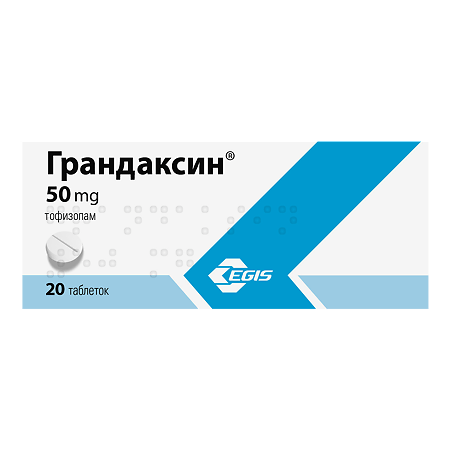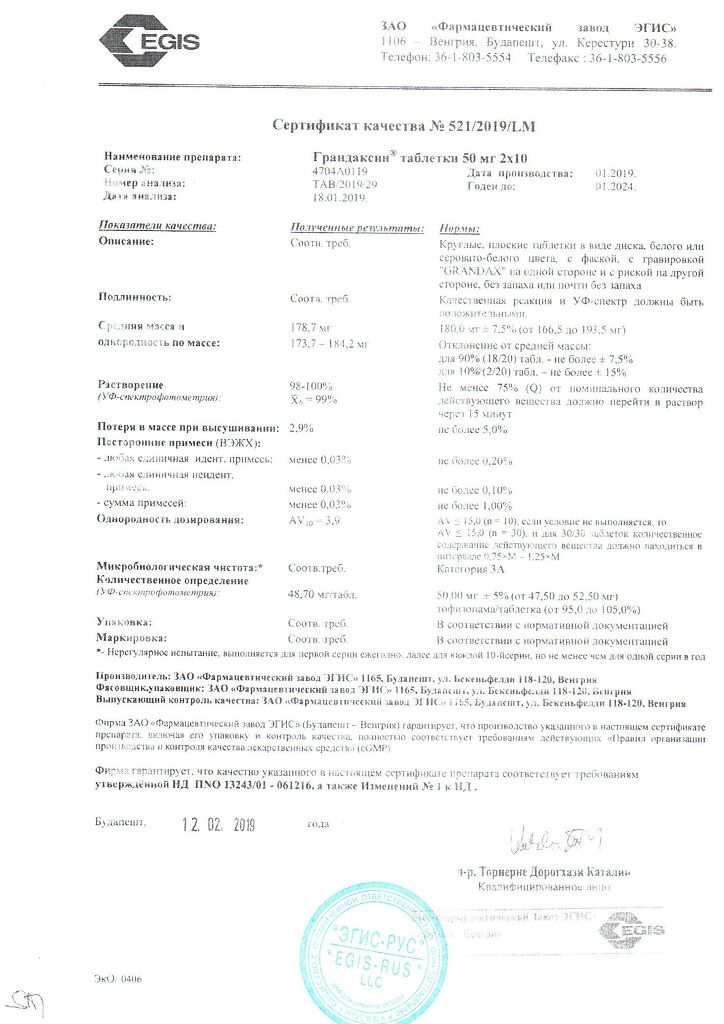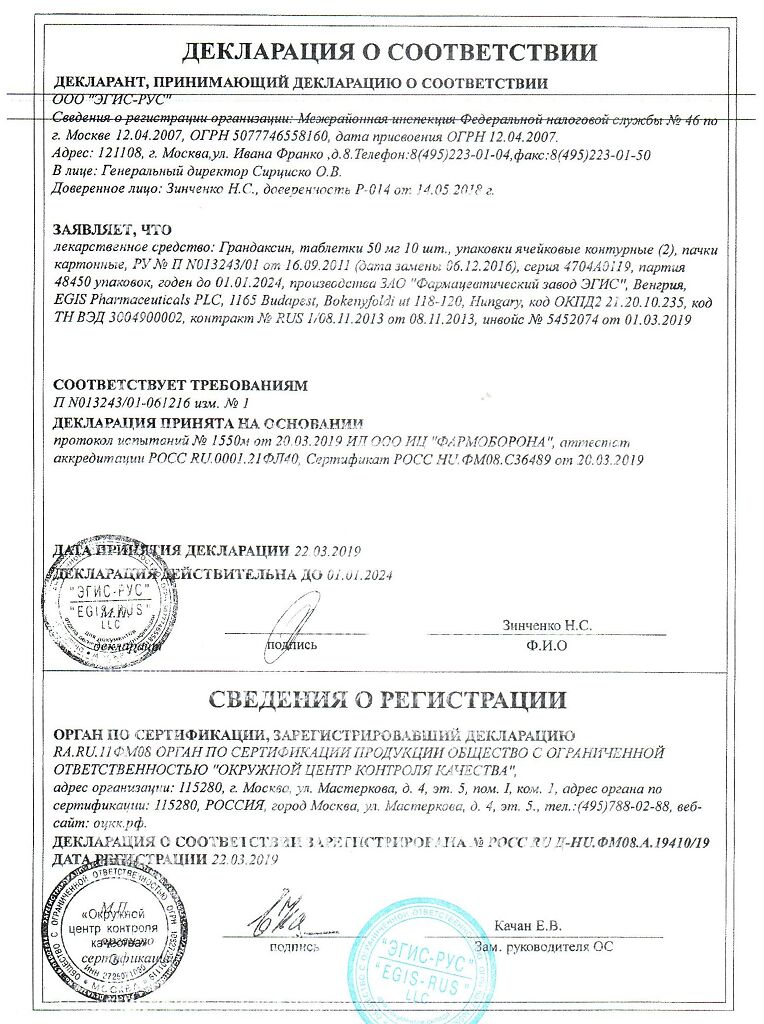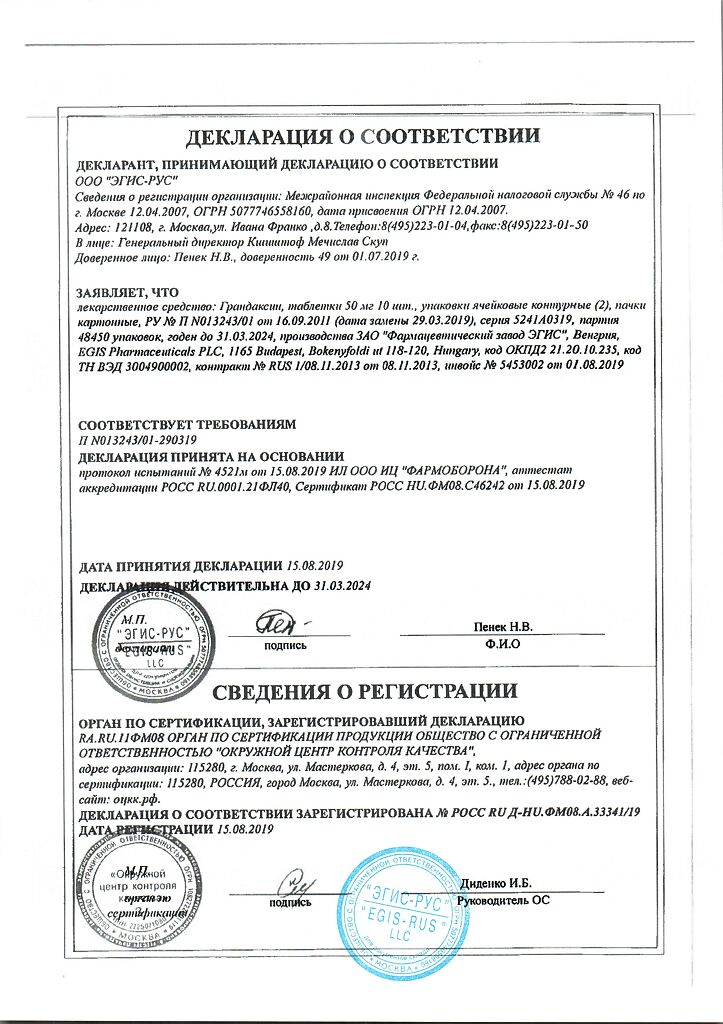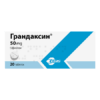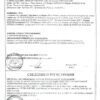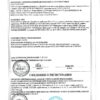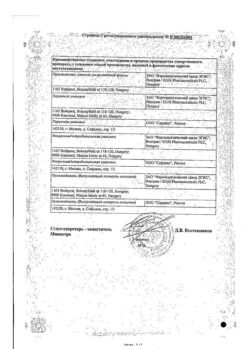No products in the cart.
Grandaxin, tablets 50 mg, 20 pcs.
€14.44 €12.03
Out of stock
(E-mail when Stock is available)
Description
Pharmacodynamics
Tophizopam is a mild anxiolytic with short-term action and a broad therapeutic index. The exact mechanism of action is unknown. Tofizopam differs from other 1,4-benzodiazepines both in its chemical structure and in its clinical and pharmacological effects.
The drug is effective in treating anxiety disorders, including those accompanied by vegetative manifestations, fatigue, apathy. Unlike other benzodiazepines, tofizopam has no sedative, hypnotic, muscle relaxant and anticonvulsant activity. The drug does not have adverse effects on memory, psychomotor and cognitive function, but has moderate stimulant activity.
Because of absence of muscle relaxant effect the drug can also be used in patients with myopathy, myasthenia gravis and neurogenic muscle atrophy in which the use of muscle relaxants is contraindicated or undesirable. With long-term use, tofizopam does not cause the development of physical or mental dependence.
Pharmacokinetics
Intake. When administered orally, it is rapidly and almost completely absorbed from the gastrointestinal tract. Cmax is reached within 1-1.5 h.
Distribution. About 50% of tofizopam is bound to blood proteins.
Metabolism. After absorption, tofizopam undergoes significant presystemic metabolism in the liver. The main metabolic pathway is demethylation.
Elimation. It is excreted mainly by the kidneys (about 60%) and in the form of metabolites through the intestine. T1/2 is 6-8 hours.
Indications
Indications
treatment of mental (neurotic) and psychosomatic disorders accompanied by emotional stress, anxiety, autonomic disorders, apathy, fatigue and depressed mood;
alcohol withdrawal syndrome.
Pharmacological effect
Pharmacological effect
Pharmacodynamics
Tofisopam is a mild anxiolytic with short-term action and a wide therapeutic index. The exact mechanism of action is unknown. Both in its chemical structure and in its clinical and pharmacological effect, tofisopam differs from other 1,4-benzodiazepines.
The drug is effective in the treatment of anxiety disorders, incl. accompanied by vegetative manifestations, fatigue, apathy. Unlike other benzodiazepines, tofisopam does not have sedative, hypnotic, muscle relaxant or anticonvulsant effects. The drug does not have an adverse effect on memory, psychomotor and cognitive function, but has moderate stimulating activity.
Due to the lack of a muscle relaxant effect, the drug can also be used in patients with myopathy, myasthenia gravis and neurogenic muscle atrophy, in which the use of muscle relaxants is contraindicated or undesirable. With long-term use, tofisopam does not cause the development of physical or mental dependence.
Pharmacokinetics
Suction. When taken orally, it is quickly and almost completely absorbed from the gastrointestinal tract. Cmax is achieved within 1–1.5 hours.
Distribution. About 50% of tofisopam is bound to blood proteins.
Metabolism. After absorption, tofisopam undergoes significant first-pass metabolism in the liver. The main metabolic pathway is demethylation.
Excretion. It is excreted mainly by the kidneys (about 60%) and in the form of metabolites through the intestines. T1/2 is 6–8 hours.
Special instructions
Special instructions
Particular care is required when treating patients with compensated chronic respiratory failure or who have previously suffered acute respiratory failure.
Caution is necessary when treating elderly patients and persons with mental degradation, as well as those with impaired renal and/or liver function, because they are more likely than other patients to experience adverse drug reactions.
When combining the drug Grandaxin® with drugs that suppress the function of the central nervous system (antidepressants, sedatives, hypnotics, opioid analgesics, general anesthesia), antihistamines, antipsychotics, alcohol, mutual effects may be enhanced.
It is not recommended to use the drug for chronic psychosis, phobias or obsessive states. As inhibition decreases, the risk of suicide attempts and aggressive behavior increases. Therefore, Grandaxin® is not recommended as monotherapy for depression or depression accompanied by anxiety.
Caution is required when treating patients with personality disorders (psychopathy).
The drug should be used with increased caution in case of organic brain lesions (for example, atherosclerosis).
In patients with epilepsy, Grandaxin® may provoke seizures.
This drug is not recommended for use in patients with angle-closure glaucoma.
Risk when used concomitantly with opioids. Concomitant use of Grandaxin® with opioids increases the risk of sedation, respiratory depression, coma, and death. Due to the increased risk, concomitant use of sedatives is only possible in patients for whom alternative treatment options are not possible. If a decision is made to concomitantly prescribe Grandaxin® with other sedative drugs, the lowest effective doses should be used and the duration of treatment should be as short as possible. These patients require careful monitoring for symptoms of respiratory depression and sedation. Therefore, it is strongly recommended that patients and their caregivers (if any) be educated about the symptoms of respiratory depression and sedation.
The drug Grandaxin® contains lactose. Each tablet of Grandaxin® contains 92 mg of lactose monohydrate. This should be taken into account by patients suffering from rare hereditary diseases, incl. galactose intolerance, complete lactase deficiency and glucose-galactose malabsorption.
Impact on the ability to drive vehicles and operate machinery. During the period of use of the drug, driving vehicles and/or working with complex mechanisms that require increased concentration are prohibited.
Active ingredient
Active ingredient
Tofisopam
Composition
Composition
Active ingredient:
tofisopam50 mg;
Excipients:
stearic acid – 1 mg;
magnesium stearate – 1 mg;
gelatin – 3.5 mg;
talc – 2 mg;
potato starch – 20.5 mg;
lactose monohydrate – 92 mg;
MCC – 10 mg
Pregnancy
Pregnancy
Pregnancy. Tofisopam penetrates the placental barrier. The use of this drug during pregnancy is contraindicated.
Breastfeeding period. The drug is excreted into breast milk, so it is not recommended for use during breastfeeding.
Contraindications
Contraindications
hypersensitivity to tofisopam, other benzodiazepine derivatives, as well as other components of the drug;
conditions accompanied by severe psychomotor agitation, aggression or severe depression;
decompensated respiratory failure;
obstructive apnea syndrome;
coma;
simultaneous use with tacrolimus, sirolimus, cyclosporine;
lactase deficiency, lactose intolerance, glucose-galactose malabsorption (the drug contains lactose monohydrate);
pregnancy;
breastfeeding period;
children under 18 years of age.
With caution: undecompensated chronic respiratory failure; history of acute respiratory failure; angle-closure glaucoma; epilepsy; organic brain damage (for example, atherosclerosis); combined use with opioids; elderly patients and patients with impaired liver or kidney function.
Side Effects
Side Effects
Adverse reactions are listed below by organ system class and frequency: very often (≥1/10); often (≥1/100, <1/10); uncommon (≥1/1000, <1/100); rare (≥1/10000, <1/1000); very rare (≤1/10,000) or observed with unknown frequency (cannot be estimated from available data).
In each frequency category, adverse reactions are listed in order of decreasing severity.
For most adverse reactions, there is no data to determine their frequency.
Mental disorders: very rarely – confusion; frequency unknown – agitation, increased irritability, feeling of mental stress, loss of appetite.
From the nervous system: insomnia; very rarely – the drug can provoke seizures in patients with epilepsy.
From the respiratory system, chest and mediastinum: respiratory depression.
From the gastrointestinal tract: nausea, vomiting, constipation, flatulence, dry mouth.
From the liver and biliary tract: very rarely – cholestatic jaundice.
From the skin and subcutaneous tissues: exanthema, scarlet-like exanthema.
From the skeletal system, muscle and connective tissue: muscle tension, muscle pain.
General disorders and disorders at the injection site: headache, itching.
Interaction
Interaction
Plasma concentrations of drugs that are metabolized by the CYP3A4 isoenzyme may increase when taken simultaneously with tofizopam, therefore the simultaneous use of tacrolimus, sirolimus, cyclosporine and tofizopam is contraindicated.
The use of tofisopam with drugs that have a depressant effect on the central nervous system (analgesics, general anesthesia, antidepressants, sedatives, hypnotics), H1-histamine receptor blockers, antipsychotics enhances their effects (for example, sedation or respiratory depression).
Opioids: Concomitant use of sedating drugs, such as benzodiazepines or related drugs such as Grandaxin®, with opioids increases the risk of sedation, respiratory depression, coma, and death due to the additive depressant effects of these drugs on the central nervous system. The dosage and duration of combined use of such drugs should be limited.
Inducers of liver enzymes (alcohol, nicotine, barbiturates, antiepileptic drugs) can increase the metabolism of tofisopam, which can lead to a decrease in its concentration in the blood plasma and a weakening of the therapeutic effect.
Some antifungal drugs (ketoconazole, itraconazole) can slow down the hepatic metabolism of tofisopam, which leads to an increase in its concentration in the blood plasma.
Some antihypertensive drugs (clonidine, BMCC) may enhance the effects of tofisopam. β-blockers may slow the metabolism of the drug, but this effect is not clinically significant.
Digoxin: Tofisopam may increase plasma concentrations of digoxin.
Warfarin: Benzodiazepines may interfere with the anticoagulant effect of warfarin.
Disulfiram: Long-term use of disulfiram may inhibit the metabolism of tofisopam.
Antacids have different effects on the absorption of tofisopam. Cimetidine and omeprazole inhibit the metabolism of tofisopam.
Oral contraceptives may reduce the rate of metabolism of tofisopam.
Alcohol: Tofisopam reduces the inhibitory effect of alcohol on perception.
Overdose
Overdose
Symptoms: CNS suppressive effects appear only after taking high doses (50–120 mg/kg). Such doses may cause vomiting, confusion, coma, respiratory depression and/or seizures.
Treatment: in case of severe suppression of central nervous system functions, it is not recommended to induce vomiting. Rinse the stomach. The introduction of activated carbon helps reduce the absorption of the drug. Basic physiological parameters should be constantly monitored and appropriate symptomatic therapy should be used. If respiratory depression occurs, mechanical ventilation can be performed. Administration of CNS stimulants is not recommended. Hypotension is best treated with IV fluids and placing the patient in the Trendelenburg position. If these measures do not restore blood pressure levels, dopamine or norepinephrine can be administered. Dialysis and induced diuresis are ineffective.
Flumazenil can be administered as an antagonist, but its use in tofisopam overdose has not been clinically tested.
Storage conditions
Storage conditions
At temperatures between 15 and 25 °C
Keep out of the reach of children.
Shelf life
Shelf life
5 years
Do not use after the expiration date indicated on the package.
Manufacturer
Manufacturer
EGIS, Hungary
Additional information
| Shelf life | 5 years Do not use after the expiration date stated on the package. |
|---|---|
| Conditions of storage | At 15 to 25 °C Keep out of reach of children. |
| Manufacturer | EGIS, Hungary |
| Medication form | pills |
| Brand | EGIS |
Other forms…
Related products
Buy Grandaxin, tablets 50 mg, 20 pcs. with delivery to USA, UK, Europe and over 120 other countries.

